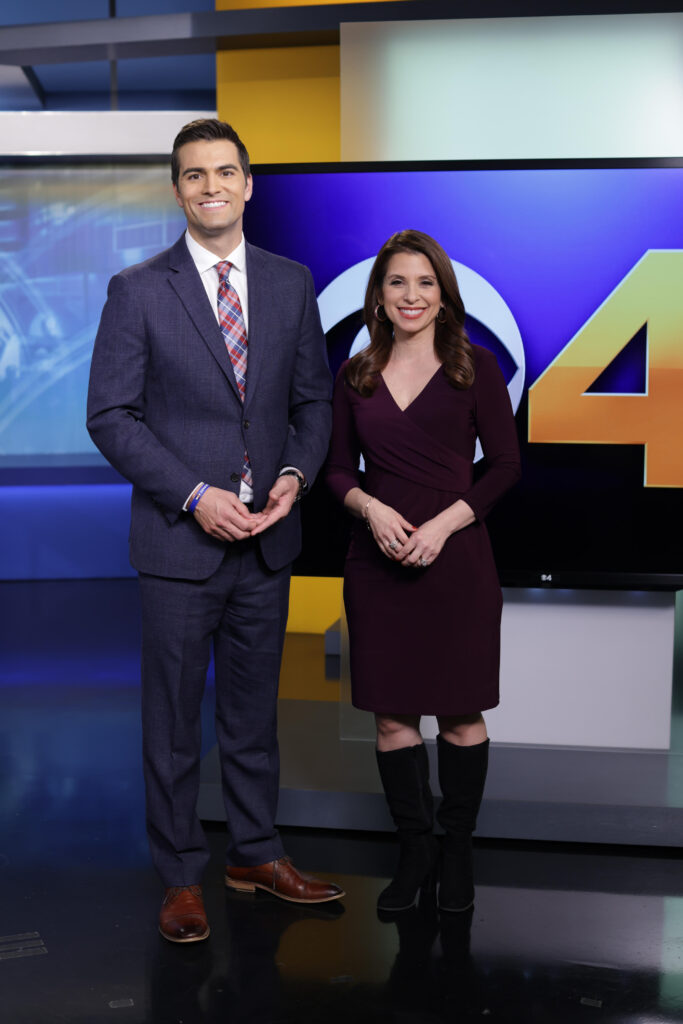By Ernest Gurulé
Think of famous pairs. Hope and Crosby, Rogers and Astaire, Thelma and Louise. Now think early morning Denver television and something else comes to mind: Griego and Garcia, CBS4’s first, and very likely, also Colorado’s first ever Latino television news co-anchor team. Denver natives Michelle Griego and Dominic Garcia say ‘good morning’ to thou- sands across Denver and beyond every Monday through Friday beginning at 4:30 a.m.

While most stations were not late to the show with male-female co-anchor teams or even two women as the face of a newscast, seeing two Hispanic news anchors as a station’s brand was rare. You might see it in a Houston or San Antonio, even a Los Angeles, but not in Denver, a city whose Latino population exceeds thirty percent.
But Griego and Garcia greet the city and region every weekday professionally and affably with all the news that’s fit to share. For Griego, this is a rebound relationship with Denver, where she worked before getting an offer she calls too hard to refuse. The offer was the morning news gig in San Francisco where she worked for nearly a decade. “I loved its beauty and diversity,” she said of the city. “There was always something to do. If we wanted, we could get out of the Bay area and in ninety minutes be in Carmel.”
The ‘we’ she refers to is the family that has grown as she’s built her career over the last two decades. In addition to her husband, Macario, the pair also have three daughters ranging in age from six to 22. Working mornings as she does, she said, is not only a professional decision but also a personal one. “When you have a family, it really is the best shift,” though admitting, it can be exhausting. “I have to drink a lot of coffee,” she jokes.
If Griego seems familiar to Denver news watchers, it should shock no one. Hard to believe, but she began earning her ‘chops’ while still in elementary school as the anchor of a kids news show on Denver’s KWGN, Channel 2. The news bug never left and followed her to Fort Collins and CSU and later to Denver’s Metropolitan State University.
Garcia was similarly bitten. He’s been fascinated with journalism and news from his earliest memory. He said his father, a college professor, sort of steered him in that direc- tion. “He didn’t see me sitting in an office,” Garcia recalled. His mother, an attorney, apparently agreed. And Garcia, who readily admits to his rocky, though not necessarily irrecon- cilable relationship with math, found something everyone could agree on.
It was at Denver’s Thomas Jefferson High School, where he read the school’s daily news and information that he bonded with what would become his career. Like his morning news partner, he also went to CSU where he immersed himself in the journalism school’s student newscast. The training would ultimately land him in Albuquerque, New Mexico, where he got his first on-air job and stuck around for three years.
Like Griego, Garcia’s followed a slightly nomadic career path. From New Mexico, he returned to Denver and Channel 4 but then followed his wife, Meghan, to San Diego. There he landed at the CBS affiliate where he did everything from reporting to anchoring, including anchoring sports when needed. The couple returned to Denver in 2018.
Television news diversity has changed dramatically over the years. The Griego-Garcia team is just one example. One look at News4’s webpage and its newsroom staff is a light year removed from just a generation ago. There is a cornucopia of hues and surnames that would never have been found not that long ago. But while diversity continues to grow in newsrooms, there remain undercurrents and, in some cases, obvious challenges.
Last year, Denver’s KUSA’s newsroom was rocked by the story of the firings of three Latina reporters. Both the Denver Post, Westword and scores of other news outlets reported on the terminations of Lori Lizarraga, Kristen Aguirre and Sonia Gutierrez. Each was let go after not having their contracts renewed within the course of a single year. All three had complained about the difficulties they had in the Channel 9 newsroom particularly in their reporting of stories involving the Latino and immigrant communities.
Having a diverse newsroom, both Griego and Garcia agree, elevates the quality of the news product. It helps illuminate different perspectives and experiences. That’s why the product he puts out, said Garcia, has to reflect substance over style. “I have always wanted to pride myself on my work,” adding, “I definitely have an obligation to give voice to certain communities.”
The face of television has evolved in a positive way, said Griego. But it’s not just who you see that is important. “It’s important to have that representation not only on TV but behind the scenes,” said Griego. She’s an undiluted advocate for a newsroom that looks like the community it serves.
One advantage Griego has parlayed in her newscasts, is having the ‘ear’ for surnames. It’s just respectful, she said, to pronounce them not only the way they should be pronounced but also accepting the way the person themself says it. She just wants to get them right. Passing judgment on the way someone might say their name is not part of her makeup. “You have to understand how they grew up,” she said.
Being the faces of a major city and entire region via television more than a dozen hours a week might make one a ‘celebrity,’ but neither Griego nor Garcia think that way. Each sees themselves as just people doing the best job they can. But each acknowledges respect for those who either inspired or helped steer them in the direction they ultimately charted.
For Griego, long-time Denver’s 7 news anchor Anne Trujillo was and is the North Star for her own career. Former Channel 7 anchor Bertha Lynn was also a television role model.
For Garcia, himself a prototypical news anchor, stylish, urbane and smooth, the late Peter Jennings was the gold standard. Watching Jennings’ ad lib coverage of the September 11th attacks on New York nearly two decades before was and is, he said, as amazing today as it was nearly two decades before.


